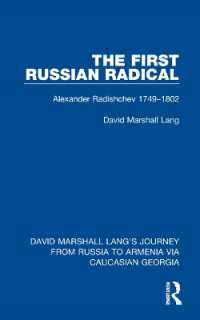Full Description
Frans Floris de Vriendt radically transformed Netherlandish art. His monumental mythologies introduced a new appreciation for the heroic nude to the Low Countries and his religious art challenged standards of decorum. Born into a family of sculptors and architects, Floris refashioned his art through travel, first studying with the humanist painter Lambert Lombard in Liège and then continuing on to Italy. These experiences defined the hybridizing novelty of his art, forged by juxtaposing antique and modern, Italian and northern sources. This book maps Floris's hybrid style onto shifting conceptions of cultural, religious, and political identity on the eve of the Dutch Revolt. It explores his collaborations and rivalries, engagement with artistic theory, hierarchical workshop, and revolutionary use of print.
Contents
Map of Antwerp (1565)
Acknowledgements
Abbreviations
List of Figures
1 Introduction. Fall and Redemption: The Divine Artist
2 A Portrait of the Artist: Floris's Biography in Context
3 Iter Italicum: Floris's Italian Journey in Context
4 Triumphal Entry: Floris's Return to Antwerp (1546-49)
5 The Floris Workshop: Practice, Theory, Ritual
6 Portraits and Head Studies
7 Experiments in Religious Art: Style and Audience
8 Ardens amator artium: Floris, Niclaes Jonghelinck, and the Nature of Netherlandish Art
9 Losing Faith: Floris's Allegory of the Trinity
10 Iconoclasm and Poesie
11 Humanæ Societati Necessaria: Frans Floris's Vision for the Arts
12 Coda
Appendix A: Mentions of Floris in Literary Sources
Appendix B: Catalogue of Known Drawings in the Lost Album Dansaert
Appendix C: Text and Music of the chanson "Le Cruel Mars"
Appendix D: Timeline of Floris's Chief Dated Works in Historical Context
Checklist of Paintings
Checklist of Drawings
Checklist of Prints
Notes
Bibliography
Index







